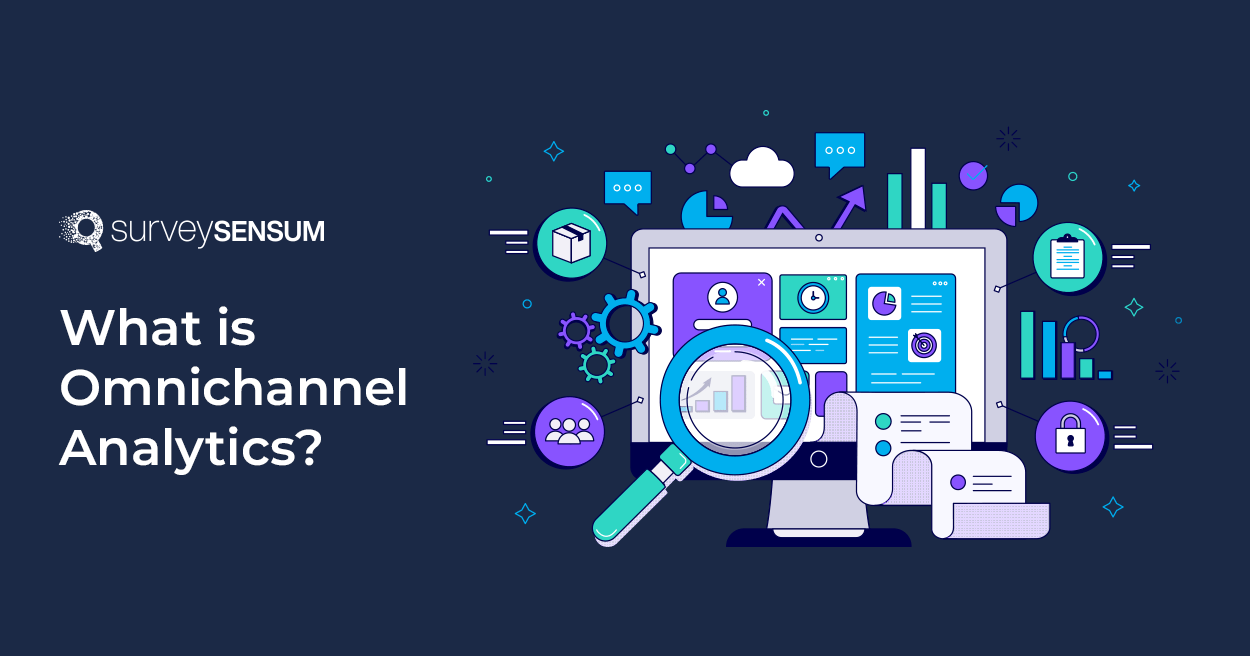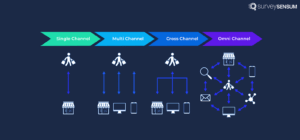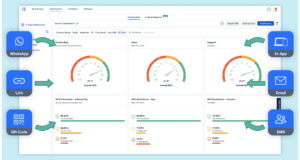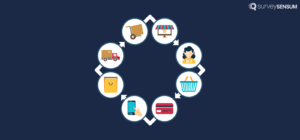Innovative Team Collaboration: 3 Tools for Seamless Project Management
Read More

Mira is a crazy shopper and a pro at getting amazing deals. Whenever I want to buy something beyond my budget, I run to Mira. So, one day I observed the master at work. I saw that she explored at least 5 different shopping websites to shop for a pair of black heels. Finally, through a social media referral, she snagged the heels at a WHOPPING 25% DISCOUNT compared to the price listed on the brand’s website. Amazing, right?
That’s how the current way of shopping in this digital age is – the omnichannel shopping experience.
Interestingly, Google reports that 90% of device owners switch between devices to complete a task, averaging three devices per day. This highlights a significant trend – customers aren’t sticking to a single device or channel to make a purchase. Instead, they effortlessly transition between mobile apps, desktop searches, social media, and even in-store visits.
This fluid movement across different channels emphasizes the importance of an integrated and cohesive omnichannel strategy for brands, ensuring they meet customers wherever they are in their shopping journey.
Now, the question here is – how do brands bridge this gap between online, offline, and multi-channel shopping to create a seamless shopping experience and be where their customers are?
– With Omnichannel Analytics and the right customer feedback tool.
But what is omnichannel analytics and why and how can brands implement it? Well, scroll down, and let’s find out!
What is Omnichannel Analytics?
Why Do You Need an Omnichannel Approach to Analytics and Reporting?
Omnichannel analytics refers to the practice of collecting, analyzing, and interpreting customer feedback and data from various channels and touchpoints across the customer journey.
And why does this matter?
Well, by understanding this intricate dance, you can tailor your strategies to match your customer’s needs and preferences. You can create personalized experiences, offer the right deals at the right time, and make sure your customers feel like they’re getting the same shopping experience across all channels, no matter how they prefer to shop.

What is Omnichannel Experience?
The term “omnichannel” highlights the importance of maintaining a consistent and seamless customer experience across different touchpoints, ensuring a unified interaction no matter the channel or device customers use.
But why do you need to implement an omnichannel approach? Let’s see.
Have you ever faced challenges while ordering food online? Issues like late delivery or quality concerns often prompt customers to contact support. Picture this: a chatbot initially addresses simple concerns, but then human agents step in, requiring you to repeat details.
A centralized omnichannel system would have notified the agent of the issue no matter how many channels are involved.
That’s the power of adopting an omnichannel analytics approach – a streamlined and integrated system that enhances customer support and overall experience.
Let’s understand some of the important benefits of omnichannel analytics.

Consider the above example, if the agent knew where and how you interacted across your customer journey, then there would have been no need for you to describe your issue twice – saving both your and the agent’s time and effort.
Gaining a 360-degree view of the customer journey through omnichannel analytics allows businesses to gather insights from various customer interactions. These insights empower sales representatives and customer support agents to personalize their approach and better meet the specific needs of individual customers.
Gather Customer Feedback Across Customer Journey

According to research conducted by Google and IPSOS, more than 80% of consumers opt for research online and purchase offline or vice-versa?
This staggering number shows that your customers are all over the place. They shift from one channel to another based on their convenience.
But how can you effectively reach them across all channels?
With omnichannel analytics.
The omnichannel analytics approach enables you to collect and integrate data from various customer touchpoints like social media platforms, in-store interactions, mobile apps, and more. The goal is to have a comprehensive view of customer interactions across different channels. Now, you just need to leverage this data to personalize customer experiences.

Omnichannel analytics provides a comprehensive view of all customer journeys. This visibility allows you to efficiently identify areas where customers might be facing challenges or experiencing dissatisfaction.
For example, you notice that there’s a drop-off in the online purchase funnel for a specific product category. This is because some customers have read some negative comments on a social media platform regarding that particular product. Now, traditional analytics might only reveal the drop-off, but omnichannel analytics allows you to link this behavior to negative social media reviews.
So, instead of just addressing the symptoms of an issue, omnichannel analytics allows you to delve deeper into the data to identify the fundamental causes of customer pain points. This is essential for implementing effective and long-lasting solutions.

Did you know that 80% of customers are more likely to shop with brands if they offer personalized experiences and 90% of customers stated that they find personalized appealing?
Now, with such a high purchase rate creating a seamless, personalized, and omnichannel shopping experience to improve increased revenue is vital. In order to cater to the needs of customers across multiple channels and ensure a personalized experience, understanding their preferences, expectations, and needs becomes crucial.
By adopting an omnichannel approach, you gain insights into your customers’ identities and their anticipated requirements. The more information you gather about your customers’ shopping experiences, the better you can tailor a personalized and seamless journey for them. This approach allows you to not only meet their expectations but also exceed them by providing a more targeted and individualized shopping experience.

Omnichannel analytics acts as a singular source of truth for your entire business. All relevant data is housed in one platform, providing a consistent and reliable reference point for decision-making. This eliminates confusion caused by discrepancies in data across different teams.
With omnichannel analytics, teams can save time and effort that would otherwise be spent on manual data collection, analysis, and communication between different departments. The streamlined process allows teams to focus on more value-added activities and strategic initiatives. Imagine getting on a call with the customer and asking for details instead of having everything on your screen. What would you prefer?
With omnichannel analytics, utilize data to create detailed customer profiles that highlight their unique preferences. Along with personalized marketing strategies, you can also develop precise and targeted marketing campaigns based on insights from millions of customer interactions – enhancing marketing ROI.
When you understand your customers’ unique journey, you understand their needs and preferences better. Now, use analytics to plan for higher profitability. Create a customer-centric business by analyzing product preferences across different stores and implementing optimal pricing strategies for each product life cycle based on real-time data and market demand.

By taking an omnichannel analytics approach, you can evaluate the effectiveness of product promotions across channels to predict and plan for demand fluctuations. This way you can ensure optimal inventory levels by understanding demand patterns and adjusting stock accordingly.
For example, you notice that a particular woman’s t-shirt promoted online is flying off the shelves, both in-store and website/app. With this information, you can ensure that the item remains well-stocked online and allocate additional inventory to stores where it’s in high demand.
With omnichannel analytics, you can quickly analyze your store’s overall performance and understand your customer journey from entry to purchase – not just digitally. With this understanding, you can determine the right staffing levels and product placements to optimize productivity and increase sales.
By leveraging these benefits of omnichannel analytics, you can enhance your customer experience, improve operational efficiency, fix customer pain points across all channels, and drive overall business success.
Create Omnichannel Surveys With SurveySensum
Now, let’s understand how you can implement this approach to your business.
The benefits of implementing an omnichannel analytics approach, in this digital age, are clear as day. But still, many brands struggle with it.
According to a study done by Brightpearl, 91% of businesses claim to have an omnichannel strategy in place, but only 8% think they have mastered it.
Now, the struggle is clear here – businesses understand the importance but either they do not have the right tool or don’t understand the right process to implement it effectively. So, let’s understand how to do that.
Do you know that 87% of businesses consider omnichannel strategy as important to business success, but only 12% believe they have the right technology to implement it?
Not having the right tool for analytical purposes is a major roadblock for many businesses. Here’s how you can find the right tool for your business.
To create seamless and personalized experiences for your customers across all channels, you need to first understand how and where they are interacting with your brand across all channels. For that, you need to map all your customer journeys, so here’s how to do that.
Creating and implementing an omnichannel analytics approach will remain a half-baked strategy if you don’t analyze and take action to improve. Here’s how you can do it.
Remember that omnichannel analytics is an ongoing process, and it’s crucial to stay agile and responsive to changing customer expectations and market dynamics.
Embracing omnichannel analytics is more than a strategic choice for businesses in this digital age – it’s a transformative journey toward a customer-centric and data-driven future. The true power of omnichannel analytics lies in its potential to drive informed decision-making across marketing, sales, and customer service.
However, implementing this approach requires a cohesive omnichannel strategy. With this right strategy in place, you can turn raw data into actionable insights that fuel innovation and continuous improvement for your business.
Now, to do that you need a robust analytics tool, like SurveySensum, that will enable you to gather and analyze multichannel data on a single powerful and customizable dashboard for comprehensive understanding.
